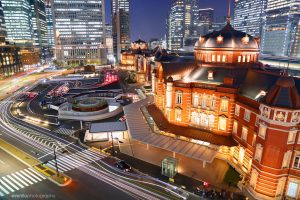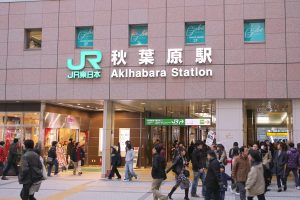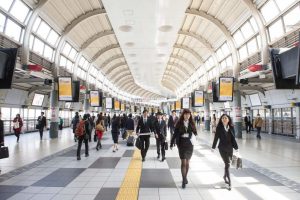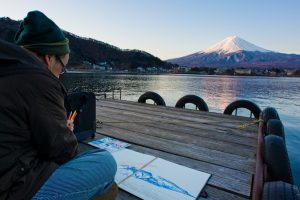Tokyo is the capital city of Japan and the most populous metropolitan area in the world. It is located on the southeastern side of the main island Honshu, in the Kantō region, and includes the Izu Islands and Ogasawara Islands.
This captivating city has something for everyone, from the majestic temples of traditional Japan to the bright neon lights of Shibuya.
In addition, Tokyo boasts more Michelin-starred restaurants than any other city in the world, has a cosmopolitan nightlife, and is a beacon for pop culture and fashion.
This travel guide will help you plan all aspects of your trip to Tokyo, including transport and sightseeing.
Top attractions in Tokyo
Tourists in Tokyo are spoiled for choice when it comes to attractions. However, with so much to see and do, deciding what to visit during your stay in the city can be a challenge.
To help you make your mind up, we’ve put together a selection of guides to some of the best places to visit in Tokyo. From shopping and dining to historical and cultural attractions, our guides have you covered.
Tokyo Imperial Palace
Also known as Kōkyo, this palace in Tokyo is the residence of Japan’s Imperial Family. The Imperial Place is defined by distinctive whitewashed buildings with sloping roofs in a historic Japanese style, and is surrounded by a vast, formidable moat.
Visitors to Tokyo are encouraged to take a guided tour of the extensive, elegant palace grounds. These include the Imperial Palace East Gardens, which houses the large collection of the Museum of the Imperial Collection, and Kitanomaru Park, home to the National Museum of Modern Art.
Shibuya crossing
One of the busiest pedestrian crossings in the world, Shibuya crossing is perhaps the most iconic symbol of the city of Tokyo around the world.
Shibuya Crossing’s large advertising screens and heavy foot traffic means it is often compared to the Times Square intersection in New York and Piccadilly Circus in London, and it is often seen as representative of the ultra-modern image of Tokyo projected worldwide.
Sensoji temple
Sensoji temple, also known as Asakusa Kannon and located in Tokyo’s Asakusa district, is the city’s oldest religious building and one of its most colorful and popular.
With roughly 20 million annual visitors, it’s also the most visited-temple in Japan and the most-frequented spiritual site in the world.
Tokyo Skytree
Rising above the Tokyo skyline is a structure that looks like a conglomeration of the Eiffel Tower and the Seattle Space Needle. It is one of the tallest structures in the world, and it combines Tokyo’s futuristic character with traditional Japanese values. How?
The Tokyo Skytree was built using the same principles as the Japanese pagoda, a type of tower with many roofs stacked atop one another. Its stability springs from its central pole, called a shinbashira. In the case of the Skytree, this central pole is in the form of a massive concrete tube, fastened to the rest of the tower using fuel dampers invented by NASA. Even in an earthquake, the tower is designed to sway against this pole without sustaining harmful structural damage.
Gotokuji temple
Gotokuji temple (護国寺 in kanji) is well known across Japan as the supposed origin of Maneki-neko, the “beckoning cat” figurine which is said to bring good fortune and success to its owner if kept in their bedroom or place of study.
Many people across the world mistakenly believe that this good luck talisman is Chinese in origin due to its popularity among Chinese and Vietnamese communities. However, the birthplace of Maneki-neko is undoubtedly in Japan, and one of the most popular legends links it directly to Gotojuki.
Tsukiji outter market
The streets are narrow and full of people. Cardboard produce boxes line the aisles, overflowing with tall leeks, sturdy root vegetables, brightly colored citrus fruits, and more. The boxes are stacked to chest height to allow easy access to the items they contain. Nearby, chefs prepare sushi and other mouth-watering delicacies at small outdoor food stalls.
This is Tsukiji Jogai Shijo, the Outer Market of Tsukiji.
Tokyo Disneyland
In 1983, Tokyo Disney became the first Disney theme park to open outside of the United States. It is located alongside the Tokyo Disney Resort, just a 5-minute walk from Maihama Station.
The park stretches out across 7 distinct zones and includes a range of classic Disney rides such as Space Mountain, It’s a Small World, Star Tours, and the Haunted Mansion. An ideal destination for a family day out while in Japan’s capital.
Yoyogi park
Yoyogi Park, called Yoyogi-Koen in Japanese, has been described as “one of the liveliest parks in the city.” It is also one of the largest green spaces in Tokyo. It is located conveniently between two other bucket list areas, Shibuya and Harajuku.
Festivals and other events are held there almost every weekend. Whether you’re traveling solo, in a group, as a couple, or with children, Yoyogi Park offers something for everyone.
Studio Ghibli museum
Located in Tokyo’s Mikata district, the Studio Ghibli Museum was established by Hayao Miyazaki, a master of Japanese anime. Miyazaki is the director behind award-winning, acclaimed childhood films such as My Neighbor Totoro (1988), Spirited Away (2001), and Howl’s Moving Castle (2004),
The museum is an interactive experience dedicated to a studio often called the ‘Disney of Japan’ and is suitable for the entire family. It identifies itself as “a portal to a storybook world” and boasts a number of exhibits including enormous statues of Ghibli characters and exclusive short films.
Read more...
Snoopy museum
The Peanuts comic strip created by Charles M. Schulz is one of the most successful and recognizable cartoons ever created, running for over 50 years and grossing over US$1 billion in revenue, going on to spawn several television specials and animated films.
Getting around Tokyo
With an area of almost 850 square miles (almost 2,200 square kilometers), tourists in Tokyo have a lot of ground to cover.
Fortunately, getting around Japan’s capital is easy with your Japan Rail Pass.
Planning how to get from A to B is an essential part of preparing for your trip. Check our guides to public transport in Tokyo to work out how to reach your destination by train or bus.
The JR Pass in Tokyo
Tokyo, the capital city of Japan, is the most densely populated metropolitan city in the world, home to nearly 40 million people. The Tokyo Metropolis, as the area is officially known, spans nearly 850 square miles (nearly 2,200 square kilometers). Tokyo enjoys a rich cultural history, as it has been the seat of government in Japan since the year 1603. Tokyo is comprised of twenty-three wards, each operated as an individual city.
Getting around in a city of this size – especially as an international traveler – may at first seem intimidating. However, Tokyo’s public transportation system, which includes airports, trains, buses, taxies, and pedestrian traffic – has been designed operate smoothly.
Your Japan Rail Pass covers all of the major JR train lines in Tokyo. With your Pass in hand and with the help of this travel guide, you will soon be navigating the streets and stations of Tokyo like a pro.
Prepaid IC Cards: Suica
Navigating international travel can be daunting, whether you're a novice voyager or a seasoned globetrotter. Yet, Japan has always striven to simplify its internal transportation for everyone, resident or tourist. Their ingenious solution? The IC Card, designed to make traveling throughout the country as effortless as a gentle summer breeze.
Read more...
Narita Express from Narita Airport to Tokyo
The Narita Express - also known as N'EX - is the most convenient Tokyo city transfer from and to Narita International Airport, which hosts most of the overseas flights to Japan.
This limited express train service is fast, reliable and punctual, and you can ride it for free with your Japan Rail Pass. Find out all the travel details in this post.
Tokyo Monorail from Haneda Airport to Tokyo
The Tokyo Monorail Haneda Airport Line, often called simply the Tokyo Monorail, began operation in 1964. It was the first commercial monorail system in the world. The elevated straddle-beam monorail line parallels the coast of Tokyo Bay. Travelers can enjoy seaside views, and on clear days, Mount Fuji is visible in the distance.
Haneda Airport is ideal for travelers wishing to reach Tokyo, as it is much closer to the city center than Tokyo’s Narita Airport. It is also the busiest airport in Japan. The Tokyo Monorail is there to ease this inherent congestion and make travel to and from the airport an excursion in itself.
Yamanote Loop Line
The JR Yamanote line is probably the most popular and convenient way for getting around Tokyo.
Japan Rail Pass holders can take advantage of the line for free. Taking any train on the Yamanote line is fully included in the JR Pass.
Chuo-Sobu Line
Do you have plans to visit Tokyo? If you do, you’ll likely be using Japan’s extensive commuter train system to get around. The railways in Japan are quick and efficient, as well as affordable – especially if you take advantage of the Japan Rail Pass, which fully covers it and allows to ride it for free!
When traveling in Tokyo, common train lines include the 60 kilometers that make up the Chuo-Sobu Line. This line runs east and west across Tokyo, between Chiba Station and Mitaka Station. It is the single JR line that crosses the circle of the Yamanote Line, and it serves as a major artery for local commuters as well as other travelers.
Keihin-Tohoku Line
The Keihin-Tohoku Line is a busy train line connecting the cities of Saitama, central Tokyo and Yokohama, among others. The line’s name is derived from Tokyo, Yokohama, and Tohoku Main Line when written in Japanese characters. The train line has been in operation for well over 100 years, having taken on its first passengers in 1914.
Your Japan Rail Pass is valid on most trains along the JR Keihin-Tohoku Line, as it is owned by JR East. Where will your travels take you – to Tokyo, Yokohama, or elsewhere? When will your trains depart, and when are the stations the most crowded? Check out this handy travel guide for more information.
Main train stations in Tokyo
There are several train stations in Tokyo. Depending on where you come from, or where you’re going, you’ll find yourself in one or more of these stations during your trip.
These guides provide useful information about the main train stations in Tokyo. Find out where they are located and which Japan railway lines make stops.
You can also get out about the services and facilities you can expect at each one.
Tokyo station
Tokyo Station is the largest and busiest train terminal in Japan. More than 3,000 trains depart the station each day, providing transportation for over 400,000 passengers. It is located in the Marunouchi business district, not far from the Imperial Palace. During the Edo Period, this area was located within the outer moats of the castle.
Tokyo itself is a bustling metropolis, often the first part of Japan that international travelers experience. Learning how to utilize Tokyo Station as a transportation hub will help make your vacation enjoyable and worry-free.
Shibuya station
Shibuya is one of Tokyo’s 23 wards, famous for the shopping and entertainment district centered around Shibuya Station. Many of Japan’s fashion trends are born on the streets of Shibuya.
Shibuya is also a station with a long history. Shibuya Station opened in 1885 as a stop along what is now called the Yamanote Line. It was also the afternoon rendezvous of the famous dog Hachiko, now immortalized in bronze statues, film, and print.Read more...
Shinjuku station
Shinjuku is one of the 23 wards of Tokyo, and it is home to a large shopping and entertainment district surrounding Shinjuku Station. Shinjuku is the busiest rail station in the world, with more than two million passengers gracing its corridors each day.
Shinjuku is a station with a long history. It first opened in 1885 on what is now the Yamanote line. Additional lines brought an influx of commuter traffic, urging the city’s growth.
Akihabara station
Akihabara Station is located in the Chiyoda ward of Tokyo. The area is known as a lively shopping district, with many stores specializing in electronics and otaku, the diehard anime and manga fandom. Akihabara was named for the Akiba, a local shrine formerly found there. Akiba was the god of fire, and Akihabara means “autumn leaf field.”
Hamamatsucho station
If you’re traveling in Tokyo, you might find yourself passing through Hamamatsucho Station. The station is located in the Hamamatsucho business and commercial district of Tokyo’s Minato special ward. It provides access to loads of attractions in the Tokyo Bay area.
This station is over 100 years old, first opened in 1909. Today, it serves more than 150,000 travelers daily. You can use this handy guide, along with your Japan Rail Pass, to travel quickly, easily, and affordably in and around Hamamatsucho Station.
Ikebukuro station
Tokyo’s Ikebukuro Station is one of the busiest train stations in the world, second only to Shinjuku Station. The station has a long history, having opened in 1903. In 1903, around 28,000 passengers used the train station each day. Today, that number is over two million, including local commuter as well as tourist traffic.
Ikebukuro is the main station in the north-west of Tokyo. This shopping and entertainment district boasts unique shops and indoor theme parks, many of which cater to the anime and manga fandom. Use this guide to find your way around Ikebukuro Station.
Nippori station
Nippori Station, called Nippori-eki in Japanese, is located in Arakawa, a Tokyo’s special ward. The station, like Tokyo itself, enjoys a long and abundant history. “Nippori” means “place where the sun sets”, and this quiet area hearkens back to the charms of yesteryear.
Nippori Station was inaugurated in 1905. Today, it serves over one hundred thousand passengers each day. Will your travels take you through Nippori Station? Employ this handy travel guide to learn about the station’s train lines and nearby attractions.
Sendagaya station
Sendagaya Station is located in the Shibuya special ward of Tokyo. It first opened its doors in 1904. As of 2011, Sendagaya Station was serving more than 20,000 passengers daily.
Sendagaya Station will have the special privilege of helping visitors access the New National Stadium for the opening ceremonies of the Tokyo 2020 Olympics.
Shimbashi station
Shimbashi means “New Bridge,” and Shimbashi Station serves just such a purpose in Tokyo’s Minato special ward. Previously known as Karasumori Station, Shimbashi Station’s current location first opened its doors in 1909. Its predecessor, the original Shimbashi Station which opened in 1872, is located a few kilometers away. It is one of the oldest train stations in Japan and serves as a museum. Today, Shimbashi Station serves more than 250,000 passengers each day.
Shinagawa station
Shinagawa Station is among the oldest train stations in Japan, having opened its doors in 1872. Interestingly, the station became operational four months prior to the inauguration of the first railway in Japan.
While none of the original structure remains, Shinagawa Station continues to play a role in the rail history of Japan. The introduction of the Shinkansen bullet trains to Shinagawa helped alleviate the congestion of other busy Tokyo stations. In less than a decade, Shinagawa will be among the first stations in the world to host the innovative, gravity-defying maglev train.
Ueno station
Located in the Taito ward of Tokyo, Ueno Station has long been a traditional transportation hub. It was constructed in 1883 and inspired a pre-1912 poem by the young Ishikawa Takuboku. A memorial plate concerning the poem can be viewed inside the station. Today, Ueno Station is utilized both by local commuters and the long distance trains coming to Tokyo from northern regions of Japan.
Smaller than many of the other stations in Tokyo, Ueno Station is well suited to the international traveler. Consider the following information to help make your trip fun and worry-free!
Yoyogi station
Yoyogi Station first opened its doors in 1906. Today, the two stations that make up Yoyogi Station serve nearly 100,000 passengers daily. As part of the Yamanote Loop, Yoyogi is a popular station, especially for those attending a sporting event or seeking an escape from the city in the spacious Yoyogi Park and its environs.
Yoyogi will also serve as an important hub during the 2020 Tokyo Olympic Games. Plan your trip today with the aid of this handy travel guide.
Ebisu station
The large city of Tokyo is divided into a number of special wards or municipalities. Tokyo’s Shibuya ward is home to the neighborhood of Ebisu, which contains a JR East railway station of the same name.
Suggested itineraries for Tokyo
To get the most out of your trip to Tokyo, you should consider making a travel itinerary. Avoid missing out on Tokyo’s top attractions by planning each day of your visit.
Here you can find a selection of Tokyo itineraries depending on your length of stay. Browse the different options and choose one that works best for you.
If you prefer, you can also use these itineraries as inspiration for your own, personalized Tokyo itinerary.
3 days in Tokyo
As most trips to Japan begin their story in Tokyo, here is a three days itinerary, which will take you to all the great places this ever-surprising metropolis has to offer.
By taking all of the advantages of your Japan Rail Pass, in this compact travel guide we will show you how to make the most out of your stay in Tokyo: where to go, what to see and what to do, for the best prices!
5 days in Tokyo
You’ve got just five days to explore one of the largest, most vibrant cities in the world – Tokyo, Japan. With the help of this travel guide, you’ll be able to make the best use of your time – and your Japan Rail Pass – to glimpse all that the Neon City has to offer.
This guide is designed to appeal to travelers with a wide range of interests, including anime and manga fans, history buffs, foodies, and nature lovers. If one “day” of this itinerary is more interesting to you than another, feel free to expand that day’s activities while omitting others. You can also check our Tokyo 3-day itinerary if you plan to stay shorter!
Day trips and nearby destinations
Tokyo is the perfect base for exploring other areas of Japan. Thanks to Tokyo’s excellent transport connections, it’s easy to travel to nearby destinations.
Escape the fast pace of the city by taking a day trip to Mount Takao, Kamakura, or Hakone. You can also reach Mount Fuji from Japan using your Japan Rail Pass.
Check out these guides to the best destinations near Tokyo for more information.
Visiting Mount Fuji from Tokyo
A day-trip from Tokyo to Mount Fuji and the lesser-known Hakone five lakes area is among the favorite experiences of many travelers to Japan, so here is our guide on how to visit this famous landmark with the Japan Rail Pass. Whether you prefer climbing or a more relaxed pace, we have the perfect guide for you make the most out of this trip!
Reaching Hakone from Tokyo
Hakone is renowned for the stunning views it offers of Mount Fuji and Lake Ashi. Situated less than 100 km west of Tokyo, the scenic location is popular for day trips and weekend breaks.
There are a number of popular attractions in Hakone. Many people go there specifically for the onsen (hot springs) and the town has some fascinating points of cultural interest too, including the Hakone Shrine and the Hakone Open Air Museum.
Mount Takao day trip
Tokyo is a bustling metropolis, a busy and populous neon city. If you’re visiting Tokyo but looking to slow the pace and enjoy the great outdoors, nearby Mount Takao may be just the ticket. Mount Takao offers autumn leaf and cherry blossom viewing, hiking, sky lifts, animal encounters, and historic temples.
Tokyo to Nikko by train
Nikko is a historic and scenic retreat in the heart of Japan, nestled in the mountains north of Tokyo. Located at the entrance to Nikko National Park, the town offers beautiful mountain vistas, waterfalls, and hot springs.
Boasting a range of hiking opportunities, the Nikko area has also been sacred to the religions of Buddhism and Shinto for many centuries. The town was declared a UNESCO World Heritage Site in 1999 and is perhaps most famous for Toshogu, one of the most intricately decorated shrines in Japan.
Kamakura from Tokyo
Often called “the Kyoto of Eastern Japan”, this charming coastal town is located about an hour south of Tokyo and is perfect for a relaxing day trip from the capital. Its beaches, historical structures, and monuments make Kamakura a go-to destination year-round.
The area is especially good for viewing cherry blossoms in the spring and colorful foliage in autumn. The numerous historic temples, such as Kotoku-in and its famous giant Buddha statue, also make it an ideal location to learn about Japanese religious culture.
Visiting Yokohama
Japan’s second-largest city after Tokyo, Yokohama is located half an hour south of Tokyo. One of the first Japanese ports to open to foreign trade, in 1859, Yokohama has a reputation as a truly multicultural city and draws a large number of both Japanese and international visitors.
Its range of diverse attractions includes one of the largest Chinatowns in the world, a range of gastronomic experiences such as a Ramen Museum and brewery tours, and a large zoo and sea-themed amusement park.
Ashikaga Flower Park from Tokyo
The Ashikaga Flower Park first opened in 1968 and now spans 94,000 square meters (23 acres) of land approximately 74 kilometers north of Tokyo. The park is famous across Japan for housing a 150-year-old wisteria tree which has been designated as a national monument by the Tochigi Prefecture.
In addition to this amazing natural wonder, you can experience an 80-meter tunnel of white wisteria or yellow Kibana, thousands of azaleas, hundreds of other flowers, and winter lights. The flowers themselves are also illuminated at night, providing a truly otherworldly experience.





































